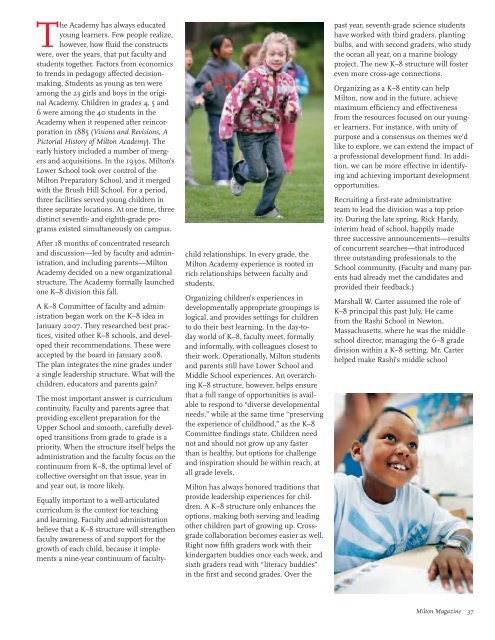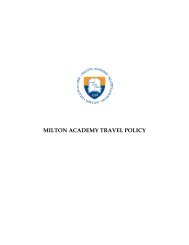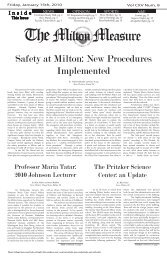Milton Magazine - Milton Academy
Milton Magazine - Milton Academy
Milton Magazine - Milton Academy
- No tags were found...
You also want an ePaper? Increase the reach of your titles
YUMPU automatically turns print PDFs into web optimized ePapers that Google loves.
The <strong>Academy</strong> has always educatedyoung learners. Few people realize,however, how fluid the constructswere, over the years, that put faculty andstudents together. Factors from economicsto trends in pedagogy affected decisionmaking.Students as young as ten wereamong the 23 girls and boys in the original<strong>Academy</strong>. Children in grades 4, 5 and6 were among the 40 students in the<strong>Academy</strong> when it reopened after reincorporationin 1885 (Visions and Revisions, APictorial History of <strong>Milton</strong> <strong>Academy</strong>). Theearly history included a number of mergersand acquisitions. In the 1930s, <strong>Milton</strong>’sLower School took over control of the<strong>Milton</strong> Preparatory School, and it mergedwith the Brush Hill School. For a period,three facilities served young children inthree separate locations. At one time, threedistinct seventh- and eighth-grade programsexisted simultaneously on campus.After 18 months of concentrated researchand discussion—led by faculty and administration,and including parents—<strong>Milton</strong><strong>Academy</strong> decided on a new organizationalstructure. The <strong>Academy</strong> formally launchedone K–8 division this fall.A K–8 Committee of faculty and administrationbegan work on the K–8 idea inJanuary 2007. They researched best practices,visited other K–8 schools, and developedtheir recommendations. These wereaccepted by the board in January 2008.The plan integrates the nine grades undera single leadership structure. What will thechildren, educators and parents gain?The most important answer is curriculumcontinuity. Faculty and parents agree thatproviding excellent preparation for theUpper School and smooth, carefully developedtransitions from grade to grade is apriority. When the structure itself helps theadministration and the faculty focus on thecontinuum from K–8, the optimal level ofcollective oversight on that issue, year inand year out, is more likely.Equally important to a well-articulatedcurriculum is the context for teachingand learning. Faculty and administrationbelieve that a K–8 structure will strengthenfaculty awareness of and support for thegrowth of each child, because it implementsa nine-year continuum of facultychildrelationships. In every grade, the<strong>Milton</strong> <strong>Academy</strong> experience is rooted inrich relationships between faculty andstudents.Organizing children’s experiences indevelopmentally appropriate groupings islogical, and provides settings for childrento do their best learning. In the day-todayworld of K–8, faculty meet, formallyand informally, with colleagues closest totheir work. Operationally, <strong>Milton</strong> studentsand parents still have Lower School andMiddle School experiences. An overarchingK–8 structure, however, helps ensurethat a full range of opportunities is availableto respond to “diverse developmentalneeds,” while at the same time “preservingthe experience of childhood,” as the K–8Committee findings state. Children neednot and should not grow up any fasterthan is healthy, but options for challengeand inspiration should be within reach, atall grade levels.<strong>Milton</strong> has always honored traditions thatprovide leadership experiences for children.A K–8 structure only enhances theoptions, making both serving and leadingother children part of growing up. Crossgradecollaboration becomes easier as well.Right now fifth graders work with theirkindergarten buddies once each week, andsixth graders read with “literacy buddies”in the first and second grades. Over thepast year, seventh-grade science studentshave worked with third graders, plantingbulbs, and with second graders, who studythe ocean all year, on a marine biologyproject. The new K–8 structure will fostereven more cross-age connections.Organizing as a K–8 entity can help<strong>Milton</strong>, now and in the future, achievemaximum efficiency and effectivenessfrom the resources focused on our youngerlearners. For instance, with unity ofpurpose and a consensus on themes we’dlike to explore, we can extend the impact ofa professional development fund. In addition,we can be more effective in identifyingand achieving important developmentopportunities.Recruiting a first-rate administrativeteam to lead the division was a top priority.During the late spring, Rick Hardy,interim head of school, happily madethree successive announcements—resultsof concurrent searches—that introducedthree outstanding professionals to theSchool community. (Faculty and many parentshad already met the candidates andprovided their feedback.)Marshall W. Carter assumed the role ofK–8 principal this past July. He camefrom the Rashi School in Newton,Massachusetts, where he was the middleschool director, managing the 6–8 gradedivision within a K–8 setting. Mr. Carterhelped make Rashi’s middle school<strong>Milton</strong> <strong>Magazine</strong> 37
















